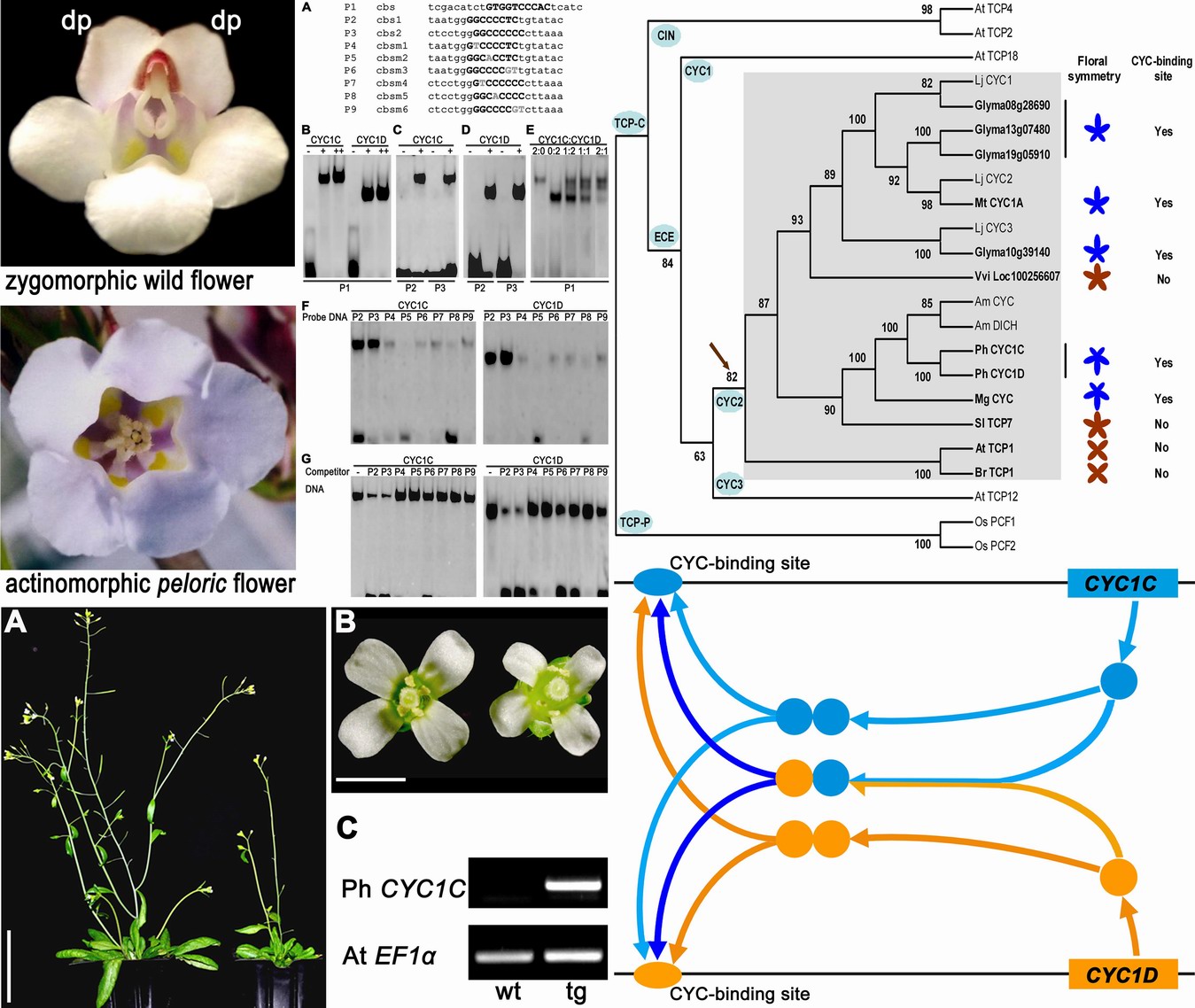The rapid development as far as we can judge of all the higher plants within recent geological times is an abominable mystery―by Charles Darwin in a letter written on 22 July 1879 to Joseph Hooker.
The explosive radiation of angiosperms in the mid-late Cretaceous puzzled Charles Darwin so much that he referred to it as an “abominable mystery”. Indeed, one key evolutionary innovation occurred independently in some major lineages of angiosperms at this time, i.e., a change in floral symmetry from radially symmetrical actinomorphic flowers to bilaterally symmetrical zygomorphic flowers. This shift further promoted the establishment of plant–insect coevolution, once established, underwent an explosive radiation in both angiosperms and insects. However, it is still a key challenge to decipher the molecular bases for the independent events leading to establishment of floral zygomorphy.
The CYC2 clade genes of TCP family of transcription factors play a crucial role in the establishment of floral zygomorphy via their dorsal identity function (i.e., determining the fate of dorsal floral organs in the second and third whorls). However, Professor WANG Yin-Zheng of the Institute of Botany, CAS and his colleagues noticed that CYC2 clade genes only transiently express in young floral meristems of ancestral actinomorphic flowers while persistently express throughout floral development in zygomorphic flowers. Therefore, they hypotheses that the regulatory changes required to maintain and strengthen CYC2 expression may represent a major step in the evolutionary origin of floral zygomorphy.
Selecting Primulina heterotricha as a model, characteristic of a zygomorphic flower with two reduced dorsal petals and abortion of both the dorsal and lateral stamens, they examined the expression and function of two CYC2 genes, CYC1C and CYC1D, and further analyzed the role of their promoters in protein–DNA interactions and transcription activation using electrophoresis mobility shift assays, chromatin immunoprecipitation, and transient gene expression assays. They find that CYC1C and CYC1D positively autoregulate themselves and cross-regulate each other. Their results reveal a double positive autoregulatory feedback loop, evolved for a pair of CYC2 genes to maintain their expression in developing flowers. Further comparative genome analyses, together with the available expression and function data of CYC2 genes in the core eudicots, suggest that this mechanism might have led to the independent origins of floral zygomorphy, which are associated with the establishment of plant–insect coevolution and subsequent explosive radiation of angiosperms.
The above research has just been published online in The Plant Cell. The Plant Cell specially highlights this paper with the title of “Transcription Factors and Darwin's ‘Abominable Mystery’: Positive Autoregulation in Floral Zygomorphy”.
Special link to http://www.plantcell.org/content/early/2012/05/29/tpc.112.099457.full.pdf+html– Yang et al. (2012). Evolution of double positive autoregulatory feedback loops in CYC2 clade genes is associated with the origin of floral zygomorphy. Plant Cell 10.1105/tpc.112.099457.
For more information, please contact Professor WANG Yin-Zheng at wangyz@ibcas.ac.cn

Combined figures of P.heterotricha
The rapid development as far as we can judge of all the higher plants within recent geological times is an abominable mystery―by Charles Darwin in a letter written on 22 July 1879 to Joseph Hooker.
The explosive radiation of angiosperms in the mid-late Cretaceous puzzled Charles Darwin so much that he referred to it as an “abominable mystery”. Indeed, one key evolutionary innovation occurred independently in some major lineages of angiosperms at this time, i.e., a change in floral symmetry from radially symmetrical actinomorphic flowers to bilaterally symmetrical zygomorphic flowers. This shift further promoted the establishment of plant–insect coevolution, once established, underwent an explosive radiation in both angiosperms and insects. However, it is still a key challenge to decipher the molecular bases for the independent events leading to establishment of floral zygomorphy.
The CYC2 clade genes of TCP family of transcription factors play a crucial role in the establishment of floral zygomorphy via their dorsal identity function (i.e., determining the fate of dorsal floral organs in the second and third whorls). However, Professor WANG Yin-Zheng of the Institute of Botany, CAS and his colleagues noticed that CYC2 clade genes only transiently express in young floral meristems of ancestral actinomorphic flowers while persistently express throughout floral development in zygomorphic flowers. Therefore, they hypotheses that the regulatory changes required to maintain and strengthen CYC2 expression may represent a major step in the evolutionary origin of floral zygomorphy.
Selecting Primulina heterotricha as a model, characteristic of a zygomorphic flower with two reduced dorsal petals and abortion of both the dorsal and lateral stamens, they examined the expression and function of two CYC2 genes, CYC1C and CYC1D, and further analyzed the role of their promoters in protein–DNA interactions and transcription activation using electrophoresis mobility shift assays, chromatin immunoprecipitation, and transient gene expression assays. They find that CYC1C and CYC1D positively autoregulate themselves and cross-regulate each other. Their results reveal a double positive autoregulatory feedback loop, evolved for a pair of CYC2 genes to maintain their expression in developing flowers. Further comparative genome analyses, together with the available expression and function data of CYC2 genes in the core eudicots, suggest that this mechanism might have led to the independent origins of floral zygomorphy, which are associated with the establishment of plant–insect coevolution and subsequent explosive radiation of angiosperms.
The above research has just been published online in The Plant Cell. The Plant Cell specially highlights this paper with the title of “Transcription Factors and Darwin's ‘Abominable Mystery’: Positive Autoregulation in Floral Zygomorphy”.
Special link to http://www.plantcell.org/content/early/2012/05/29/tpc.112.099457.full.pdf+html– Yang et al. (2012). Evolution of double positive autoregulatory feedback loops in CYC2 clade genes is associated with the origin of floral zygomorphy. Plant Cell 10.1105/tpc.112.099457.
For more information, please contact Professor WANG Yin-Zheng at wangyz@ibcas.ac.cn
 |
| Combined figures of P.heterotricha |
